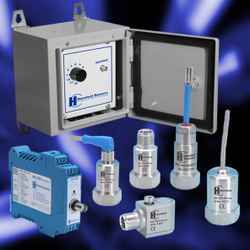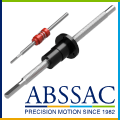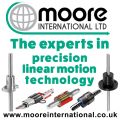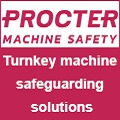
Posted to News on 9th Aug 2013, 11:10
Automation with less vibration
Hansford Sensors is promoting its range of vibration sensors and monitoring techniques that can help engineers detect and manage vibration, and thus extend the operating life of automated machinery beyond recommended maintenance intervals.

The goal for the maintenance of automation facilities is to set in place a series of procedures that will increase efficiency by preventative measures, enabling operators to minimise maintenance costs and maximise plant availability, protecting profits for operators and reducing costs for customers. Vibration monitoring tools offer a highly cost-effective method of enhancing plant performance, reducing downtime and meeting health and safety legislation. Indeed, the use of industrial accelerometers in non-safe areas is a prime requisite of health and safety legislation, and the best of today's devices and techniques enable operators to amply satisfy such robust regulations.
Mounted in a number of key positions on mechanical equipment, vibration sensors offer the potential for continuous monitoring and analysis, an inexpensive option when balanced against the potential cost of downtime on an automated line, and when condition monitoring measures are in place to detect factors such as vibration, machine downtime can virtually be eliminated.
The accelerometers used to measure levels of vibration are typically easy to install and use; however, an accelerometer is only as good as the engineer who installs it. A poorly installed or maintained accelerometer will not offer the precision or longevity of which it is capable, and so it is in everyone's interest to specify the best accelerometers and apply the best practice in managing their performance. In order to achieve this, it is worth spending a little time considering what an accelerometer is and how to effectively install one.
There are two main types of industrial accelerometer: AC accelerometers and 4-20mA accelerometers. AC accelerometers are typically used with data collectors for the vibration monitoring of more critical/complex machines, such as gearboxes and turbines. Meanwhile 4-20mA components are commonly used with PLCs to measure lower value assets, monitoring such levels as pump vibration, motor vibration and machine vibration.
Robust and reliable service
The current crop of sensors or accelerometers for vibration monitoring offered by companies such as Hansford Sensors can operate over a wide temperature range, measuring both high and low frequencies with low hysteresis characteristics and excellent levels of accuracy. These devices also offer robust and reliable service, thanks to stainless steel sensor housings that can prevent the ingress of moisture, dust, oils and other contaminants.
To specify a vibration accelerometer correctly, engineers need to consider the vibration level and frequency range to be measured, weight or fitting restrictions and environmental conditions, such as ambient temperatures, the presence of moisture, chemicals or potentially explosive atmospheres. The best approach is to work closely with a supplier that has appropriate industry experience and knowledge.
A range of capabilities are offered for those who take time to achieve the best specification. For example, if components of a vibration monitoring system are required to accommodate both slow-turning and normal running speeds there are alternatives available; the low sensitivity Hansford Sensors HS-100 Series sensor, for example, is also available to a high sensitivity specification in the form of the HS-100F, which can provide a reliable, repeatable reading even at slow running speeds.
For rotating machinery, vibration analysis has proved a convenient and highly effective method of measurement with which to assess machine condition. Accelerometers can be easily mounted on casings to measure the vibrations of the casing and/or the radial and axial vibration of rotating shafts. A typical technique in vibration monitoring has been to examine the individual frequencies within the signal that correspond to certain mechanical components or types of malfunction, such as shaft imbalance or misalignment, so that analysis of this data can identify the location and nature of a given problem. A typical example would be a rolling-element bearing that exhibits increasing vibration signals at specific frequencies as wear increases.
In the past, many engineers have genuinely believed that it is cheaper to continue running worn equipment rather than invest in replacements. However, when expensive downtime costs and catastrophic failure hit the plant this theory of "efficiency' is often proved wrong. This is why the use of condition monitoring has proved to be so cost-effective across industry: machines that have begun to exhibit defects are at greater risk of failure than those without defects, and are therefore more likely to generate unwelcome downtime costs. In contrast, a condition monitoring system enables engineers to plan maintenance and replace defective components before problems occur.
By using a network of accelerometers positioned on machinery, such as fans, motors and gearboxes, vibration monitoring can maximise revenue and make a major contribution to efficiency and productivity.
To learn more about vibration sensors and monitoring techniques from Hansford Sensors, please go to www.hansfordsensors.com.
Artisan, Hillbottom Road
Sands Industrial Estate
HP12 4HJ
UNITED KINGDOM
+44 (0)845 680 1957

































